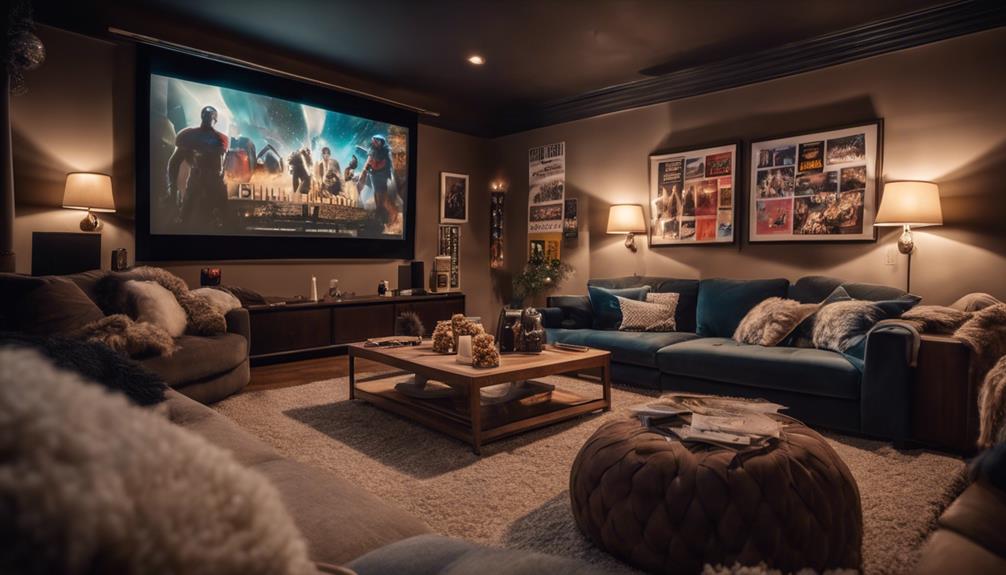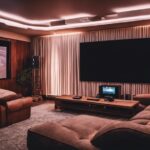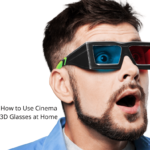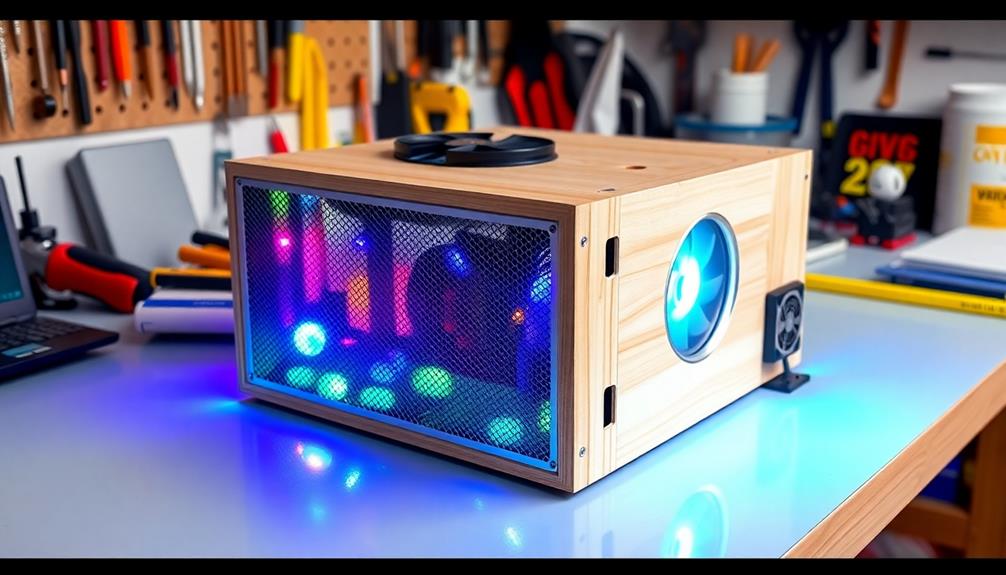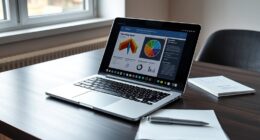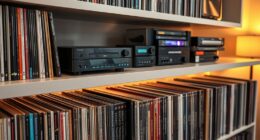Anamorphic lenses can elevate your home cinema by providing a wider, more immersive viewing experience. They expand images horizontally, ensuring you enjoy a full 2.35:1 aspect ratio without those distracting black bars. The enhanced clarity and brightness they offer make every movie night feel cinematic. Plus, these lenses maintain high compatibility with your projector, allowing seamless switching between different content formats. You'll also appreciate the vibrant HDR performance. Proper installation is key for ideal results, but once set up, you'll truly transform your home theater. Stick around to discover even more advantages and tips for maximizing your setup.
Key Takeaways
- Anamorphic lenses provide a wider aspect ratio (2.35:1) for an immersive cinematic experience without black bars.
- They enhance image quality by utilizing the full pixel panel, improving brightness and detail in 4K HDR content.
- Seamless switching between 16:9 and 2.35:1 content allows for versatile viewing without compromising image integrity.
- Proper installation and alignment maximize performance, ensuring minimal distortion and optimal image quality over time.
Anamorphic Lens Basics
Anamorphic lenses stretch images horizontally to fit wider screens, creating a more immersive cinematic experience in your home theater. These lenses are designed to optimize the 2.35:1 aspect ratio commonly used in films, allowing you to enjoy a wider field of view without the distraction of black bars.
By utilizing Horizontal Expansion and Vertical Compression techniques, anamorphic lenses enhance image quality considerably. When you incorporate high-quality options like those from Panamorph, you can support impressive resolutions, even up to 8K, ensuring your setup remains future-proof.
To maximize the benefits, it's essential to match the lens with compatible projector models and screen sizes. Proper setup is key—test various configurations to achieve the best image quality tailored to your specific environment.
With anamorphic lenses, you'll notice increased brightness, improved pixel density, and reduced distortion, making film-watching a truly engaging experience. Plus, as you eliminate black bars from widescreen films, you'll appreciate how these lenses transform your home theater into a professional-quality viewing space.
Advantages of Anamorphic Lenses

Enhancing your home cinema experience, anamorphic lenses allow projectors to display a wider 2.35:1 aspect ratio, effectively eliminating black bars and immersing you in the film. This wider aspect ratio considerably improves image quality, utilizing the full pixel panel of your home theater projectors. You'll notice increased brightness and pixel density, which is particularly beneficial for HDR content, bringing vibrant colors to life.
One of the standout advantages of anamorphic lenses is their ability to switch seamlessly between different aspect ratios, letting you enjoy both 16:9 and 2.35:1 content without any loss of quality or image distortion. By compressing images horizontally, they enhance the field of view and sharpness while reducing distortion in wide formats, elevating your viewing experience.
Additionally, high-quality anamorphic lenses are designed for continuous use, ensuring minimal image degradation over time. This helps maintain contrast and reduces excess light spill in your viewing area, providing a more cinematic feel.
With these benefits, anamorphic lenses truly transform your home theater setup, making every movie night an immersive adventure.
Installation Considerations

When you're ready to install anamorphic lenses, there are several important factors to take into account to guarantee peak performance and image quality.
Start by ensuring you have a suitable mounting plate, as many installations require a new one. This process may involve dismounting your projector for proper alignment. Misalignment can lead to lens distortion, like barrel roll, which you definitely want to avoid.
Next, check your projector settings to accommodate various aspect ratios. Anamorphic lenses can complicate this, so you'll need to configure settings correctly, like using Anamorphic Mode C for 2.35:1 content and Mode D for 16:9.
Be aware of compatibility issues with existing mounting brackets; temporary solutions may seem convenient but can lead to instability and affect image quality.
Performance Enhancements

Utilizing anamorphic lenses in your home cinema projector markedly boosts brightness and overall image quality, making your viewing experience more impactful. These lenses enhance light efficiency by using the full pixel panel of the projector, allowing for a truly immersive experience.
| Performance Feature | Benefits |
|---|---|
| Brightness | Significant increase in light efficiency |
| Image Quality | Enhanced detail and clarity for 4K HDR content |
| Constant Image Height | Eliminates black bars for a seamless viewing experience |
With high-quality anamorphic lenses, like the Panamorph Paladin, you can enjoy modern content without sacrificing detail. They also improve dynamic iris performance and adaptive tone mapping, enhancing HDR highlights for a more vivid picture. You'll find that switching between 16:9 content and 2.35:1 movies is seamless, offering versatility as you explore an increasing variety of streaming options.
Incorporating anamorphic lenses into your home cinema setup not only elevates your viewing experience but also transforms how you perceive films, making them more engaging and visually stunning.
Future Trends in Home Cinema

Embracing advancements in projector technology, home cinema enthusiasts are increasingly turning to integrated anamorphic processing for a more streamlined setup. With the rise of high-resolution projectors, you're able to enjoy native ultra-wide formats without the need for traditional anamorphic lenses. This evolution simplifies your home theater experience while maintaining cinematic quality.
As streaming services continue to deliver diverse content in various aspect ratios, the focus on flexible masking solutions has become essential. These solutions help eliminate distracting black bars, enhancing your viewing experience. You're likely to find that more DIY solutions are emerging, allowing you to achieve that cinematic feel without breaking the bank.
Moreover, community engagement in home theater forums is thriving. These platforms foster discussions that help you optimize your setup and explore the latest trends in projector technology. As fellow enthusiasts share their experiences, you can learn about innovative approaches to maximizing your home cinema's potential.
Frequently Asked Questions
Why Use an Anamorphic Lens on a Projector?
You'd use an anamorphic lens on a projector to achieve a wider aspect ratio, enhance image quality, and eliminate letterboxing. It stretches images, allowing for a more immersive viewing experience without sacrificing resolution.
What Are the Advantages of Anamorphic Lenses?
Imagine diving into a vast ocean of cinematic wonder. Anamorphic lenses expand your viewing experience, enhancing image quality and flexibility while eliminating letterboxing. You'll enjoy vibrant colors and stunning detail, making every movie night unforgettable.
Why Do Filmmakers Use Anamorphic Lenses?
Filmmakers use anamorphic lenses to create a wider aspect ratio, enhancing visual storytelling. You'll notice stunning landscapes and dramatic flares, all while maximizing image quality and immersing audiences in a mesmerizing cinematic experience.
What Are the Disadvantages of Anamorphic Lenses?
Anamorphic lenses can complicate your setup due to high costs and installation challenges. You might face image distortion, limited aspect ratio options, and potential resolution loss, especially with standard 16:9 content. Choose wisely!
Conclusion
Incorporating anamorphic lenses into your home cinema setup can truly elevate your viewing experience.
Did you know that using an anamorphic lens can increase your horizontal field of view by up to 33%? This means you'll enjoy a more immersive picture, just like in the theaters.
By embracing this technology, you're not just enhancing image quality; you're transforming your home into a cinematic haven.
So, consider adding an anamorphic lens for that ultimate movie night magic!

